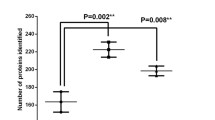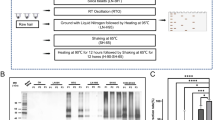Abstract
This study is an investigation on the Keratin of hair coming from 51 non-human Primates belonging to 11 families and 37 different species, using isoelectric focusing on thin layer of polyacrylmide gel (0.5 mm) in pH range 2.5–7.0 followed by silver staining.
Our results highlight that animals belonging to the same species have identical isoelectrophoretic patterns. It was proved forLemur fulvus, Macaca fascicularis, Cercopithecus aethiops, Gorilla gorilla.
Instead, regarding different species belonging to the same genus, we can say that the pattern obtained was not always characteristic of the species to which the protein belonged. In fact, whereas some species of theCercopithecus, Macaca andPapio genus show significantly different patterns, other species ofCercopithecus, Macaca, Papio, Cebus andSaimiri show identifical patterns. On the other hand, patterns belonging to different genus nearly always showed more marked differences. As for man, by means of this technique, it is possible to show a high number of polypeptides in the 3–4 pH range for non-human Primates as well.
Thus, species belonging to different families and genus can always be distinguished; on the other hand, it is not always possible for species of the same genus (e.g.Cebus, Papio).
Similar content being viewed by others
References
Budowle B. and Acton R.T., 1981.Isoelectric focusing of hair proteins. Proceedings of the 3rd international conference, Charleston, S.C., USA. Carracedo, A., Prieto, J.M., Concheiro, L.
Estefania J., 1987.Isoelectric focusing patterns of some mammalian keratins. Journal of Forensic Sciences, 32: 93–99.
Chiarelli B., 1968.Taxonomy and phylogeny of old world Primates with references to the origin of man. Ed. Rosemberg & Sellier, Torino, pp. 323+XI. Proceedings of a round table held in Turin (Italy) on 3rd–6th June, 1967.
Chiarelli B., 1983.L'origine dell'uomo. Introduzione alla antropologia, Ed. Laterza, Roma-Bari, pp. 402+XIV.
Gerhard M., 1987.Electrophoretic variability in human head hair: polyacrylamide gel electrophoresis of hair proteins in the presence of sodium dodecyl sulfate and urea. Electrophoresis, 8: 153–157.
Hrdy D.B. and Baden, H.P., 1973.Biochemical variation of hair keratins in man and non-human Primates. American Journal of Physical Anthropology, 39: 19–24.
Lindley H., et al., 1971. Cited by Marshall R.C., et al. 1977. Australian Journal of Zoology, 25: 121–132.
Marshall R.C., Frenkel M.J., and Gillespie J.M., 1977.High-sulphur proteins in mammalian keratins: a possible aid in classification. Australian Journal of Zoology, 25: 121–132.
Marshall R.C., Gillespie J.M. and Klement, V., 1985.Methods and future prospects for forensic identification of hair by electrophoresis. Journal of Forensic Science Society, 25: 57–66.
Marshall R.C. and Williams K.M., 1986.High resolution two-dimensional electrophoresis of hair proteins without prior S-carboxymethilation. Electrophoresis, 7: 524–526.
Sarich V.M. and Wilson A.C., 1967.Immunological time scale for hominid evolution. Science, 158: 1200–1203.
Author information
Authors and Affiliations
Rights and permissions
About this article
Cite this article
Folin, M., Zanella, P. & Contiero, C. An application of isoelectric focusing to non-human primates hair Keratin. Hum. Evol. 8, 1–9 (1993). https://doi.org/10.1007/BF02436460
Issue Date:
DOI: https://doi.org/10.1007/BF02436460




